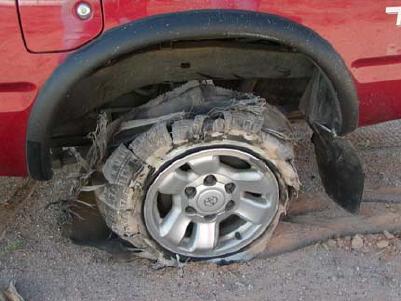 Approximately 400 people die every year in car or truck crashes that were due to tire failures, according to the National Highway Traffic Safety Administration. These tire failures can be due to a manufacturing and/or design defect, and when a person is killed due to such circumstances it is called a wrongful death suit.
Approximately 400 people die every year in car or truck crashes that were due to tire failures, according to the National Highway Traffic Safety Administration. These tire failures can be due to a manufacturing and/or design defect, and when a person is killed due to such circumstances it is called a wrongful death suit.
The most common types of tire failures are tread separation, multi-piece wheel explosions, sidewall failures, ozone cracking, and bead failures. The multipiece wheel explosion is so deadly that people have nicknamed it the “Widow Maker.” There was an attempt to ban these types of wheels, but the tire industry avoided this action by putting up signs around the workplace to warn employees about the risks of these wheels.
LEARN MORE
- A Recall of Defective Goodyear Comes Decades too Late to Save Lives
- How to Avoid RV Accidents
- Who Is Liable for a Tire Blowout Crash?
Once the cause of the tire failure is determined, we need to properly identify the tire manufacturer. This isn’t as easy as it sounds since brand names don’t automatically lead to the manufacturer. For example, if you purchased your tires at a Sears or Goodyear, the manufacturer may actually be a company which contracted out their product to these retail stores. The way to identify the tire manufacturer is with the U.S. Department of Transportation number, which is on the axle side of the tire.
When we determine who the at-fault manufacturer is and file a lawsuit, the wave of typical defense tactics will begin. The most common defense to injury or death lawsuits argued by the tire manufacturer is that, at some point, you (the injury victim) underinflated your tires, overinflated them or did a combination of both (i.e., “overdeflected”), and this improper maintenance led to the failure. We combat this argument with expert testimony refuting a relationship between these types of inflation issues and a tire failure, especially a bead separation tire failure.
Another common tactic by the tire company’s defense is to try and move the case to a federal court, as opposed to keeping the case in a state court. The defendants perceive federal court as an advantage because they view many federal judges as more sympathetic to defendants than to victims-not necessarily the case. Some injury lawyers are more familiar with the state system than federal court also. We can often combat this tactic by including a local tire store or car dealership as a defendant, and this can sometimes defeat the defenses that allow these companies to remove the cases to federal courts.
However, even if the case remains on the state level, it does not guarantee victory since tire companies routinely try to protect any and all evidence related to the case claiming “trade secrets.” We fight these claims vigorously since the information that can be revealed in discovery — the process through which both the victim’s attorney and the defense get to examine evidence — can provide helpful insights to other victims of tire failure accidents and the general public. That is how injury attorneys bring harmful conditions to light, and help avoid future similar accidents.
There’s really no telling what will happen, even if everything described above goes in favor of the victim. Tire companies have faced litigation for years, so the chances of a protracted, dragged out trial or settlement negotiation are higher for these types of product defect cases. But that does not mean you shouldn’t move forward with a serious injury claim. If you’ve suffered a serious injury and suspect it was due to a tire failure or defect, we want to hear what happened and will try our best to ensure a successful outcome.